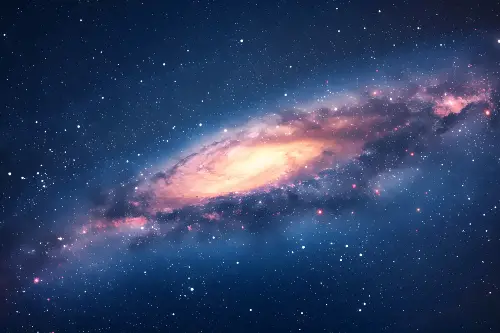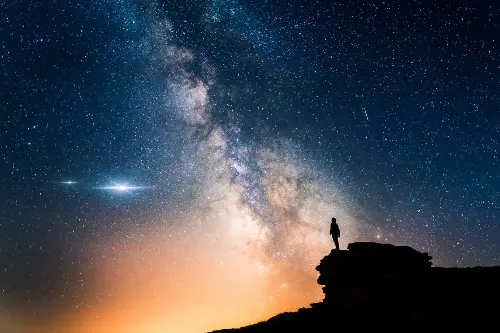Venture outside on a clear, dark night, far from the intrusive glow of city lights, and you'll be greeted by one of the most magnificent sights visible to the naked eye: the Milky Way. This celestial phenomenon has inspired tales and studies for millennia, yet it is our very own galaxy—a bustling metropolis of stars that offers both enigmatic beauty and untold stories.

Exploring the Structure of the Milky Way
The Milky Way is a barred spiral galaxy, an immense disc of stars, dust, and gas rotating in space, with filamentous arms spiralling outwards from its enter. Its heart is ablaze with the luminosity of millions of stars, pulsing with the rhythmic lifeblood of stellar birth and death. This galactic core is also home to a supermassive black hole, Sagittarius A*, which anchors the galaxy with its immense gravitational pull.
Recent estimates suggest that the Milky Way may be home to at least 100 billion stars. That number is difficult to pin down, and many astronomers believe it could be up to three times higher. Among this multitude of stars are ancient red dwarfs, vibrant main sequence stars, and colossal blue giants. Their combined brilliance weaves an intricate tapestry that adorns our night sky.
The Spiral Arms' Hidden Treasures
The Milky Way's spiral arms harbour a wide array of celestial objects. The rich interstellar dust clouds here provide fertile grounds for the birth of new stars. Stellar nurseries like the Orion Nebula can be found within these arms, and they offer an intriguing glimpse into the early chapters of a star's life cycle.
It's within these arms that we also find the remnants of violent supernova explosions. These energetic events disperse essential elements through space—elements like carbon, nitrogen, and oxygen, which are critical for the formation of planets and the advent of life. Each star's end is a cataclysmic chapter in the galaxy's ongoing narrative, contributing to the cosmos' recycling process and setting the stage for creation anew.
The Milky Way and its Galactic Symphony
The motions of the Milky Way are a galactic symphony of gravitational interactions. As our galaxy spins, it tugs and pulls on its neighbours, engaging in a cosmic dance that exemplifies the dynamic nature of the universe. Astronomers have been able to map our galaxy's rotation, revealing that it completes a full rotation approximately once every 250 million years—a year in the life of the galaxy known as a "cosmic year." Within this framework, humanity's entire recorded history is but a fleeting moment.
What's more, our galaxy is not a static entity. It's on a collision course with the Andromeda Galaxy, our nearest spiral galaxy. Billions of years from now, they are expected to merge in a dramatic event, reshaping the structure of both and birthing a new galactic arrangement. While this might sound alarming, the vast distances between stars ensure that such a galactic merger is more of a graceful waltz than a catastrophic clash.

Unlocking Galactic Mysteries
The Milky Way is not just stunning to behold—it is a significant scientific resource that continues to unlock the secrets of the universe. For instance, each flicker and fade of variable stars within our galaxy provides astronomers with clues about the inner workings of stars far beyond our own cosmic neighbourhood.
Additionally, the pulsations of rapidly spinning neutron stars, known as pulsars, have proven to be incredibly valuable tools. Pulsars act like the galaxy's lighthouses, their regular beams of light allowing scientists to measure the vast distances across space and time.
Turning to Dark Matter and Dark Energy
As we gaze upon the Milky Way's splendour, we must also confront the mysteries it holds, many of which lie in what we cannot see. Dark matter and dark energy are pervasive throughout our galaxy, influencing its structure and evolution. Dark matter, which makes up about 85% of the universe's total matter, ensures the stability of galaxies by adding to their gravitational pull. Without it, galaxies like the Milky Way would rip apart due to their high spin rates.
Dark energy, on the other hand, drives the expansion of the universe. It is the unseen force causing galaxies to drift further apart over time. As astronomers better understand these dark phenomena, they gain deeper insights not only into the fate of the Milky Way but the future of the entire universe.
A Vision for Future Generations
As residents of the Milky Way, we inherit the legacy of this celestial marvel. Its complex story—a tale of creation, evolution, and interaction—will continue to captivate and intrigue astronomers and laypeople alike for generations to come. With each stride we take in unravelling the galaxy's mysteries, we move closer to understanding our place within this starry sanctuary.
In grandeur and mystery, the Milky Way galaxy reigns supreme, its twinkling expanse a constant reminder of the cosmic puzzle box astronomers work tirelessly to decode. It beckons us to look up and wonder, to question, and to explore the enigmatic beauty and untold stories that have captivated humanity since time immemorial. For in studying the stars, we may ultimately learn more about ourselves and the boundless universe to which we belong.
